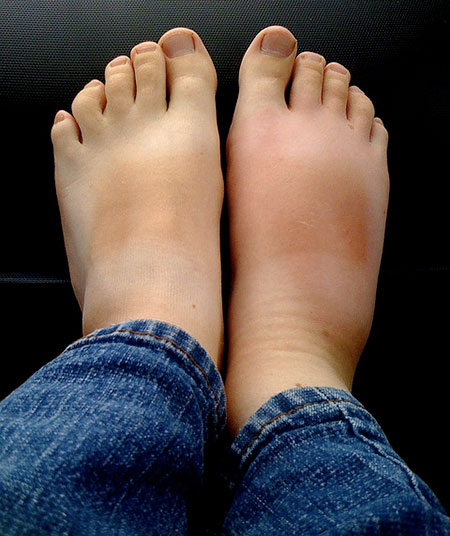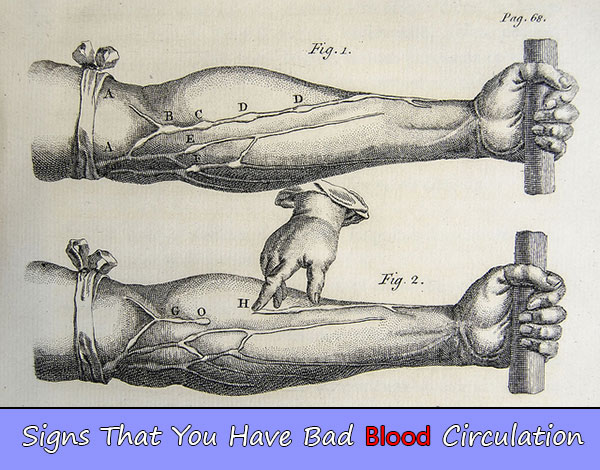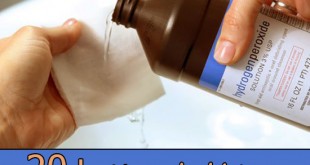Signs That You Have Bad Blood Circulation
Bad circulation can happen to us all—on cold nights when our socks aren’t quite thick enough or when we have simply been sitting still for too long. While we’ve all had this experience, if you or someone you know is constantly and desperately trying to warm hands, feet, and especially the toes, it may be a sign that something more is throwing off the body’s circulation.
What is Poor Circulation?
Simply put, poor circulation is the restriction of blood flow to certain areas of the body, mainly the hands and feet. Fat and plaque buildup is mainly the culprit and can occur due to a number or reasons.
For most, poor blood circulation can cause mild pain or discomfort. The condition generally affects adults who could use a re-vamp for a healthier lifestyle. Sometimes, however, these effects can indicate bigger problems.
Symptoms:

1. Commonly, bad blood circulation shows up as chilly toes or hands which don’t seem to warm up with normal activity. Poor circulation is definitely to blame when this happens and you are not in a cold environment.
2. If you experience tingling in the appendages, especially fingers and toes, you’ll want to move around for warmth and generate some blood flow so they don’t go to a deeper stage of numbness.
3. Numbness in fingers, toes, or other extremities can also happen with poor circulation. Take action immediately by rubbing the area, moving it, or by soaking in warm water. Appendages which lose blood flow have only a limited time before adverse effects take place, so be sure to get color back into any white or blue areas.
4. Throbbing or stinging pain in the limbs can occur in severe cases. Move around, massage the area, and consult your doctor for further treatment.
5. Due to the fact that not enough blood is being delivered to areas in your body, drowsiness and fatigue can also occur. Get moving, make sure you are drinking enough water, and you should be feeling a little more energized.
6. Dizzy spells are also caused by a lack of oxygen. If you experience dizziness at different points throughout the day, your blood sugar could be too low, or you may also be suffering from poor circulation.
7. Swelling in the feet and limbs is another effect of bad circulation, and this is caused by pooling blood and the stagnation that occurs when the blood isn’t properly flowing.
8. Poor circulation can also be the culprit for muscle cramps, or a pins-and-needles feeling. If you are prone to these sometimes painful cramps, talk to your doctor about getting your blood flow healthy again.
9. In some cases, bad circulation can cause erectile dysfunction. Rule out this possibility by consulting your physician.
Potential Causes:

Smoking is a common cause for poor circulation. Damage of the lungs caused by smoking can hinder blood flow—and therefore, the delivery of oxygen—in the body. Poor blood circulation is just one of the many harmful effects of smoking. Do your best to cut back, or even better, skip out on this habit altogether.
If you’ve let your dormant habits get the best of you, that could also be the cause for poor blood circulation. Proper amounts of exercise keep your heart, lungs, arteries, and muscles healthy, happy, and functioning. If you have fallen off the exercise bandwagon, the good news is that you can turn around your health and your blood circulation fairly quickly by implementing a little more walking, cycling, or whatever active pastime you enjoy into your day.
People who are overweight often suffer from poor circulation for many of the same reasons nonexercisers do—poor heart and respiratory health lead to poor circulation. Start introducing a few healthy dietary changes into your routine, and incrementally make your lifestyle a little more circulation friendly.
Stress at work and mainly the static task of sitting at a desk all day can contribute to poor circulation. When you feel your feet falling asleep, it’s definitely time to take a break. Get up, take a walk to your coworker’s desk or the water cooler, and take some time to reawaken your muscles and limbs. It can be hard to break focus while on the job, so a good tip for many is to set an hourly break timer—at least to get a few steps or stretches in on the regular.
Pregnancy can also interrupt a normal blood flow, because the steady stream of nutrients and oxygen are focused on reaching the baby. When this occurs, a little movement like a gentle walk. stretching, or swimming can often help. A tiny massage where on or tingly limbs is also a great idea. If uncomfortable or severe pains repeatedly occur, see your doctor for help in getting the blood flowing.
Diabetes, Raynaud’s disease, hypothyroidism, blood clots, peripheral artery disease, and adverse reactions to medications are some of the leading causes for circulation. If you are experiencing some of the severe symptoms of poor circulation, check with your doctor to rule out any these conditions.
Remedies:

Some movement can help with mild circulation problems. Start taking more walks during the workday or add some stretching to your routine. Cutting back on smoking and unhealthy food will also help in getting your circulation flowing vibrantly.
A number of herbs can have a positive effect as well. Cayenne, ginger, garlic, and gingko biloba all are great for your heart health and blood circulation. Add some cayenne pepper into your smoothies to give it an energetic kick or to a stir fry for a little extra spiciness. Ginger is another great smoothie ingredient and can make a wonderful tea. Garlic is a powerhouse spice with a lot of healthful benefits, so add it to your cooking in whenever possible! Gingko biloba is most commonly taken as a nutritional supplement. Order some from your favorite health store.
Caffeine and alcohol can be consumed, but those who suffer from poor blood circulation should be sure to limit them to moderate amounts. Smokers should try to lay off the habit as much as possible. As I said before, stretching, yoga, acupuncture, and massage can all help to get the blood flowing and your circulation up again.
 Home and Gardening Ideas At home and Gardening ideas we believe inspiring readers about homesteading, self sufficiency
Home and Gardening Ideas At home and Gardening ideas we believe inspiring readers about homesteading, self sufficiency







I have MS most of these symptoms are what I have as a result of MS so how would I know the difference? Fortunately I go to my regular doctor every six months. But if I did not how would I know if I have have poof circulation?